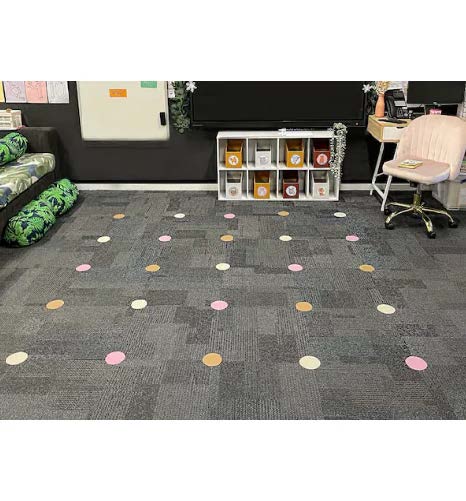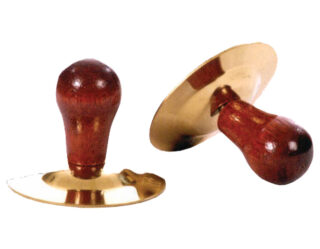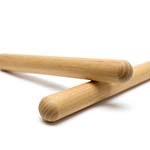
Prep. Lesson 7. Beats & bodies
- Finger cymbals, claves Difficulty:
 Prior learning: None
Prior learning: None
 This lesson develops students' physical coordination, body awareness, and confidence through whole-body movements led by various body parts, fostering individuality and expression. Using a simple Question/Answer (Q/A) form, students create a class composition in rondo form with "Tap Your Head" as the A section, exploring balanced phrasing. Alternating between spoken and sung sections, students also experience the distinction between singing and speaking voices. Students focus on resonance, control, and beat-keeping through non-melodic percussion on claves and finger cymbals. The lesson also introduces ensemble skills, encouraging students to perform with steady volume and beat while responding to simple conducting cues.
This lesson develops students' physical coordination, body awareness, and confidence through whole-body movements led by various body parts, fostering individuality and expression. Using a simple Question/Answer (Q/A) form, students create a class composition in rondo form with "Tap Your Head" as the A section, exploring balanced phrasing. Alternating between spoken and sung sections, students also experience the distinction between singing and speaking voices. Students focus on resonance, control, and beat-keeping through non-melodic percussion on claves and finger cymbals. The lesson also introduces ensemble skills, encouraging students to perform with steady volume and beat while responding to simple conducting cues.
![]()
Students will learn to create and perform new verses to "Teddy Bear," using different body parts to explore movement and creativity.
![]() Lyrics
Lyrics
Here are some new lyrics!
Teddy bear, teddy bear, stomp your feet,
Teddy bear, teddy bear, take a seat.
Teddy bear, teddy bear, spin around,
Teddy bear, teddy bear, touch the ground.
Teddy bear, teddy bear, stretch up tall,
Teddy bear, teddy bear, curl up small.
Teddy bear, teddy bear, nod your head,
Teddy bear, teddy bear, go to bed.
Teddy bear, teddy bear, flap your wings,
Teddy bear, teddy bear, dance and sing.
Teddy bear, teddy bear, blink your eyes,
Teddy bear, teddy bear, reach the skies.
Teddy bear, teddy bear, jump so high,
Teddy bear, teddy bear, wave goodbye.
- Begin by singing "Teddy Bear" together as a class to refresh the song and its actions.
- Ask students to think about different actions a teddy bear might do.
- Of course, the words don’t have to rhyme, but draw attention to them if they do. This is all part of learning to discriminate sounds, and language and music frequently cross paths in this respect.
- Provide example verses to get them started, such as "Teddy bear, teddy bear, swing your hips; teddy bear, lick your lips."
- Have students pair up to create their own verses, choosing a body part and a movement to accompany it.
- Encourage pairs to be creative and explore as many body parts as they like, such as shoulders, knees, or elbows.
- Invite pairs to present their new verses to the class.
- As each pair demonstrates their verse, have the rest of the class join in, singing and performing the accompanying actions.
 Success Criteria
Success Criteria
- I can create appropriate movements to accompany my lyrics.
- I can create a new verse for "Teddy Bear" with a partner.
- I can coordinate my body movements with the actions in my verse.
- I can perform my verse confidently in front of the class.
![]()
Students create melodic patterns, new lyrics, and actions related to a known rhyme by exploring various body part movements.
![]() Lyrics
Lyrics
Here are three examples following the same tone set and structure:
Question: "Can you tap your shoulder?"
Answer: "I can tap my shoulder."
Question: "Can you tap your ankle?"
Answer: "I can tap my ankle."
Question: "Can you tap your forehead?"
Answer: "I can tap my forehead."
 Success Criteria
Success Criteria
- I can create and sing a melodic sentence using a selection of given pitches.
- I can create appropriate movements to accompany my musical sentence.
- I can respond to my classmates’ questions by singing the answer.
- I can keep a steady pitch and rhythm while tapping different body parts.
- Begin by singing the known song "Tap Your Head" together as a class. This serves as a warm-up and prepares them for the activity.
- Sing a new question to the class: "Can you tap your elbow?" (using pitches: s, s, m, l, s, m).
- Students answer your question by singing, "I can tap my elbow." (using the same pitch set).
- Demonstrate with examples by asking students to think of other body parts they can tap, such as their knee, shoulder, or foot.
- Sing a few examples to model the Question/Answer pattern using the melody set.
- For instance, the question is, "Can you tap your knee?" The answer is, "I can tap my knee."
- Invite students to take turns asking their own sung questions using different body parts.
- The rest of the class answers by singing the response, maintaining the melody set.
- Continue allowing different students to ask their questions, with the class responding each time.
- Emphasise balancing the Question/Answer phrases without explaining the form formally—allowing students to experience it intuitively.
![]()
Students create a class arrangement in rondo form, incorporating Q/A sections sung on m, s and l pitches.
![]() Students will now incorporate the Q/A phrases they created into a larger full-class arrangement in which the rhyme ‘Tap Your Head’ is used as the A section (performed by the whole class), and the newly created segments form the other sections. Each section may be comprised of four individual creations followed by a class answer.
Students will now incorporate the Q/A phrases they created into a larger full-class arrangement in which the rhyme ‘Tap Your Head’ is used as the A section (performed by the whole class), and the newly created segments form the other sections. Each section may be comprised of four individual creations followed by a class answer.
This activity alternates between speaking voices and singing voices, introducing students to a comparison between the two. This concept will be explored in later lessons, but attention can be briefly drawn to the difference between these two ways of using the voice. Do not be concerned if some students do not actually use their singing voices in the Q/A section. This may take some time for some young children to grasp, or to attempt with confidence.

- Create a class arrangement in rondo form with the known rhyme (spoken), ‘Tap Your Head’ as the A section.
- The B, C, and D sections contain students’ questions and class answers.
- Two separate students can perform each of these sections (B, C, D, etc.). For example:
- A Section (Whole Class)
- Tap your head, tap your toe, Turn in a circle, bend down low. Tap your nose, tap your knees, Hands on shoulders, sit down, please!
- B Section
- Student 1: ‘Can you tap your elbow?’
- Class: ‘I can tap my elbow.’
- Student 2: ‘Can you tap your cheeks?’
- Class: ‘I can tap my cheeks.’
- Student 3: ‘Can you tap your fingertips?’
- Class: ‘I can tap my fingertips.’
- Student 4: ‘Can you tap your ear?’
- Class: ‘I can tap my ear.’
- A Section, etc.

 Success Criteria
Success Criteria
- I can perform with my classmates, keeping a steady beat.
- I can create a question and sing it with confidence.
- I can create a sung melody using a selection of given pitches.
- I can contribute to a group arrangement by performing my part accurately.
![]()
Students maintain balance while making floor contact with different body parts at the song's end.

 Success Criteria
Success Criteria
- I can sing while participating in the body-part touch-down game.
- I can touch specific body parts on the floor as directed.
- I can follow instructions to isolate movements in different parts of my body.
- I can contact the floor using different body parts while remaining balanced.
- Begin by singing "Ring a Rosy" together as a class. Make sure all students are familiar with the melody and lyrics.
- Explain that, in this new version, they will "touch down" a specific body part to the floor inside the circle on the last line of the song.
- Sing the song together and demonstrate by touching a chosen body part to the floor when you reach "atishoo, atishoo, we all fall down.'
- Replace this line with (for example) "Forearm, forearm, forearm touch down!"
- Have the students form a circle and sing the song together.
- At the end of the song, announce the body part they will touch down (e.g., knee, shoulder, elbow).
- Encourage everyone to touch the specified body part to the floor in time with the song.
- Continue singing and playing, choosing different body parts each time. Examples include: “Knee, knee, knee touch down!” or “Hand, hand, hand touch down!”
- Encourage students to focus on isolating the movement to the chosen body part.
- Ask the students which body part was easiest to move and which was hardest.
![]()
Students respond to silence and sound to move and stop on cue, using a range of body parts to lead their movements.

 Success Criteria
Success Criteria
- I can walk while leading with a specific body part.
- I can follow unexpected stop-and-start cues and change direction as directed.
- I can participate as a team member and stay engaged even when eliminated.
- Begin by singing and performing the known song, "Walk and You Walk", as a group, keeping a steady beat.
- Explain to students that they will walk while leading with specific body parts.
- Give examples such as "lead with your chest" or "lead with your forehead", showing how it changes the quality of movement (e.g., leading with the chest can appear proud, leading with the nose may seem curious).
- Have all students try walking while leading with each suggested body part. Guide them to notice how this changes their movement.
- Divide the class into two teams, assigning each team a different body part to lead with (e.g., one team leads with the chest, the other with the forehead).
- Let the teams intermingle as they walk through the space, observing how each group's movement feels unique.
- As they walk and sing, add stops at unexpected moments with "You walk, and you walk, and you stop" to see if they can respond quickly.
- After each stop, have them change direction before continuing.
- Reassemble the two teams on opposite sides of the room or set up a left/right formation if working in a circle.
- Set up a clear formation for each team – velcro dots can be handy.
- Repeat the activity, eliminating students who do not stop or change direction as directed.
- Continue until one team has the last remaining student, declaring them the winners.
- Students who are eliminated can help the teacher as "judges," assisting in watching for others’ movements and stops.
- Discuss how leading with different body parts felt and how the game helped them understand sound vs. silence and movement vs. stillness.
![]()
Students will learn to play percussion instruments, follow conducting cues, and participate in a collaborative ensemble.


 Success Criteria
Success Criteria
- I can play the claves and finger cymbals with a steady beat.
- I can play an instrument with other students and keep in time.
- I can respond to a conductor’s cues for when to start, stop, and adjust volume.
- Following the ensemble structure, I can play my instrument in coordination with my classmates.
- Show students a pair of claves and discuss how sound might be made. Allow a few students to try tapping techniques to explore the sound.
- Repeat this with finger cymbals or one cymbal with a triangle beater, and discuss possible ways to create sound.
- Divide the class into two teams, one using claves and the other using finger cymbals. Let each group explore ways to play their instruments and experiment with different sounds.
- For claves: Show how to hold one clave still in a cupped hand while tapping the other with a loose, bouncing motion to achieve a resonant sound.
- For finger cymbals: Demonstrate tapping two cymbals gently or using a triangle beater to create a clear sound. Emphasise controlled and gentle playing.
- Have students copy your demonstration and then swap instruments to practice both.
- Sing the new version of “Walk and You Walk” with the class, using the lyrics:"Now you play, and you play, and you play, and you play…"
- Encourage students to play their instruments along with the song.
- Sing, “Now you tap…” so that only the claves play.
- Sing, “Now you ding…” so that only the finger cymbals play.
- Alternate between sections, having one group play while the other listens, and then play both together.
- This activity introduces students to ensemble participation skills, both as performers and conductors.
- For performers: aim for a uniform medium volume and a steady beat.
- For conductors: aim for clear cueing using hand gestures, body orientation and facial expression/eye contact. (This is not meant to establish a formal conducting technique typical of a duple piece.)
- Use simple gestures to conduct different sections or adjust dynamics (e.g., raising hands for louder, lowering for softer).
- Invite volunteer students to come forward and try conducting, giving cues to each section, and directing the whole ensemble.
- Once students are comfortable, perform the ensemble piece without words, focusing on maintaining a steady beat and following the conductor’s cues for changes.
Suggested lessons
Y1. Beat II

Y1. Beat III

Y1. Beat IV

